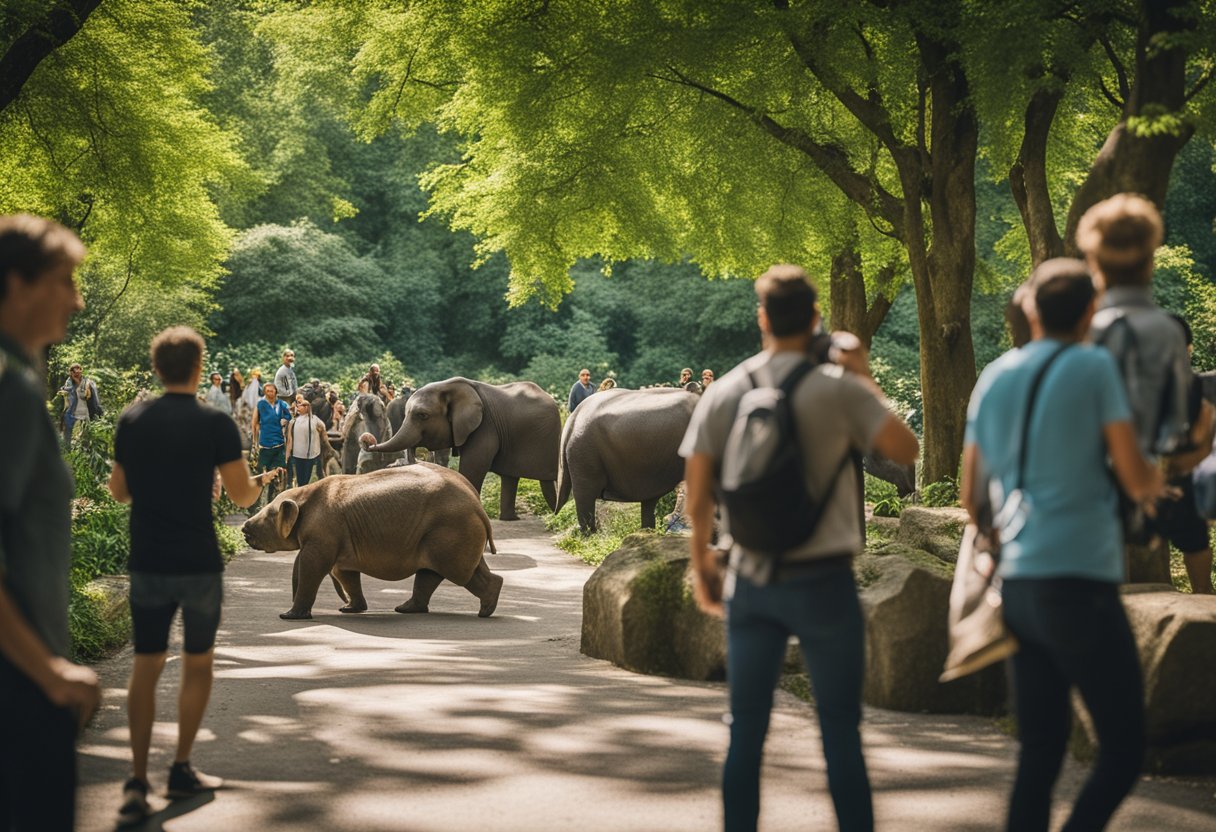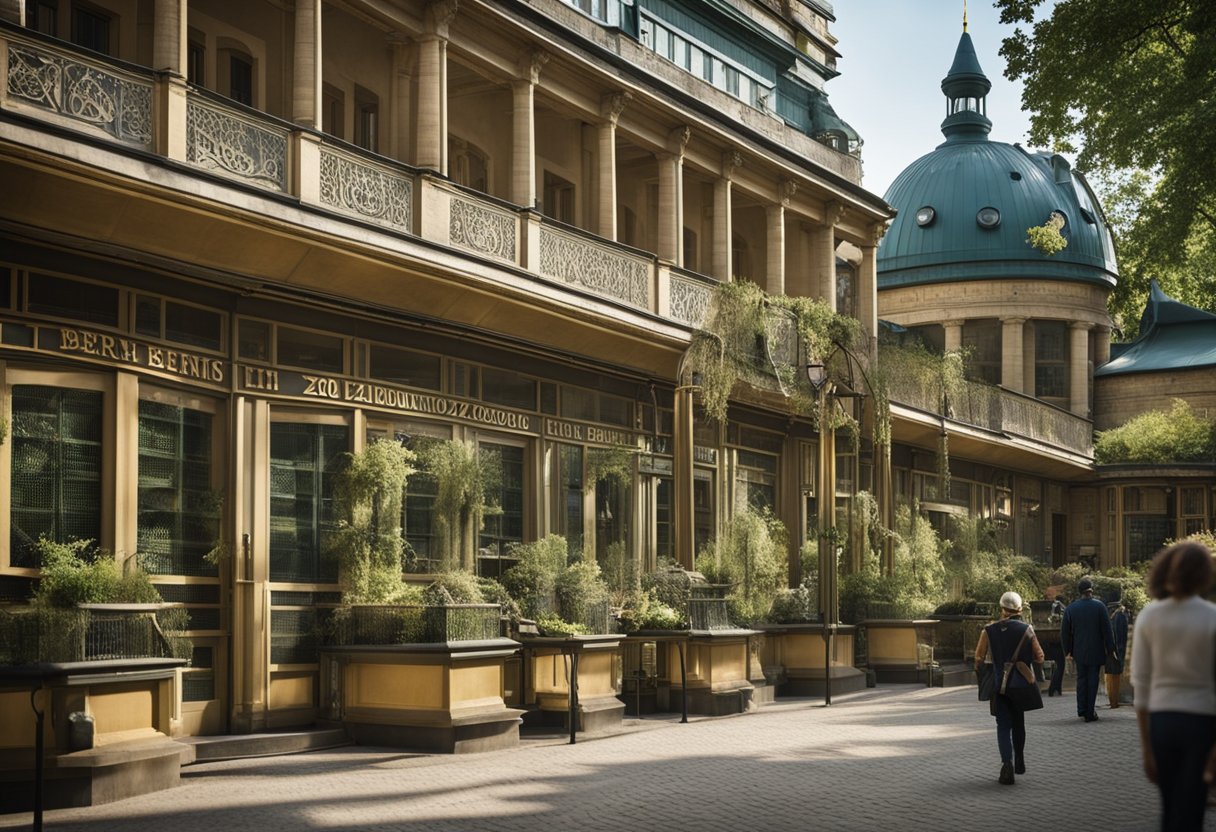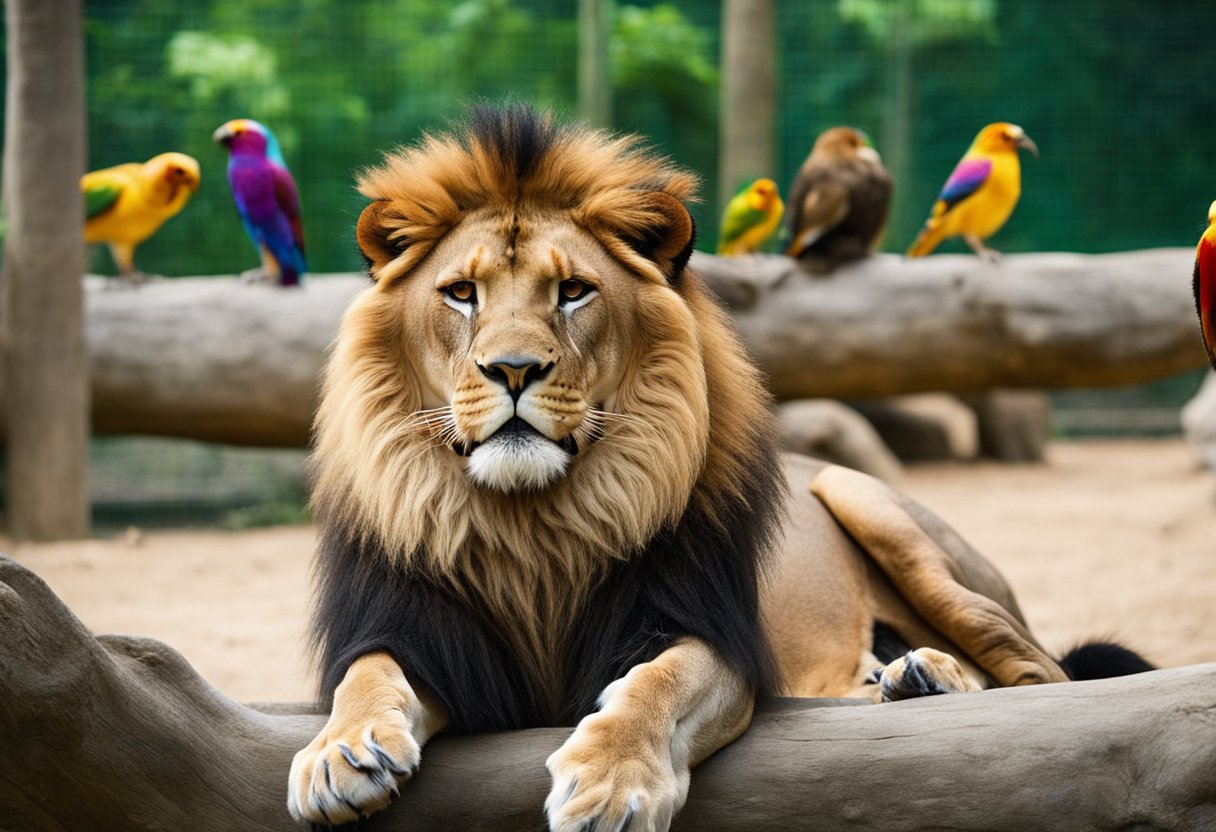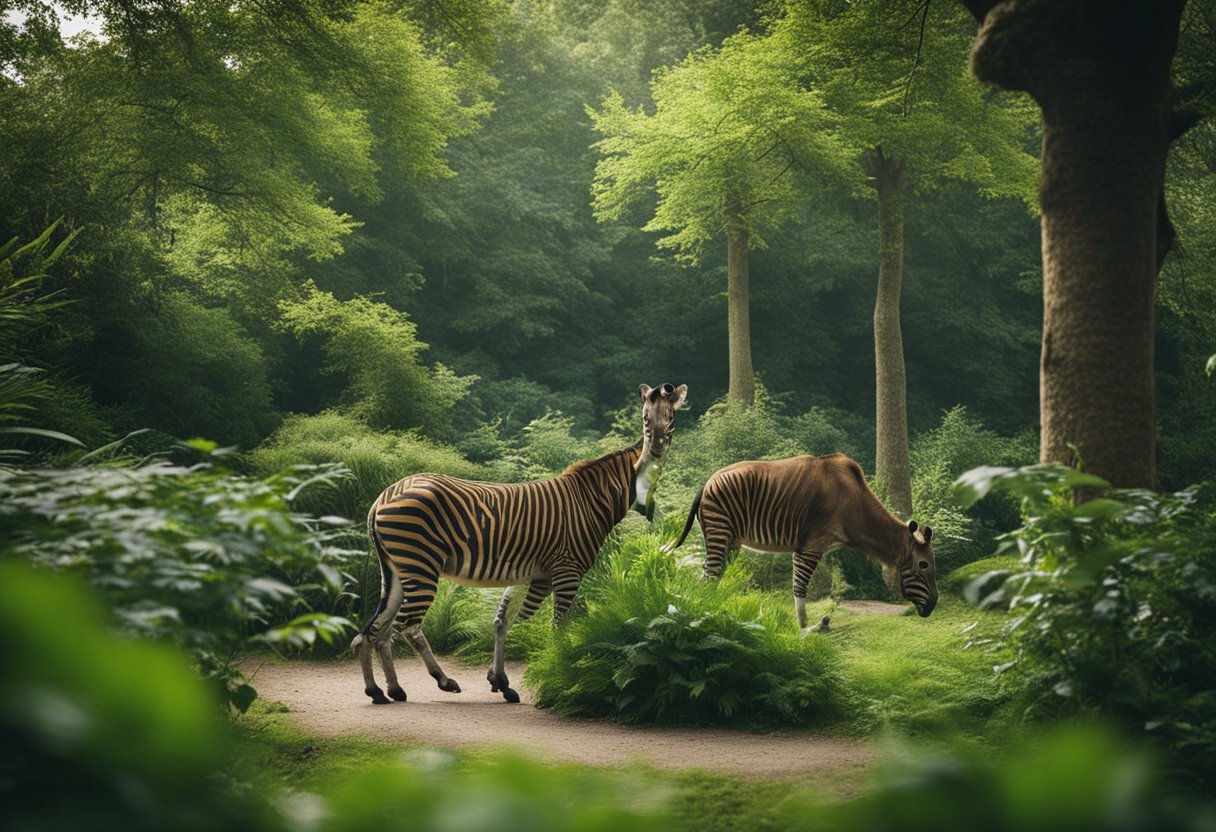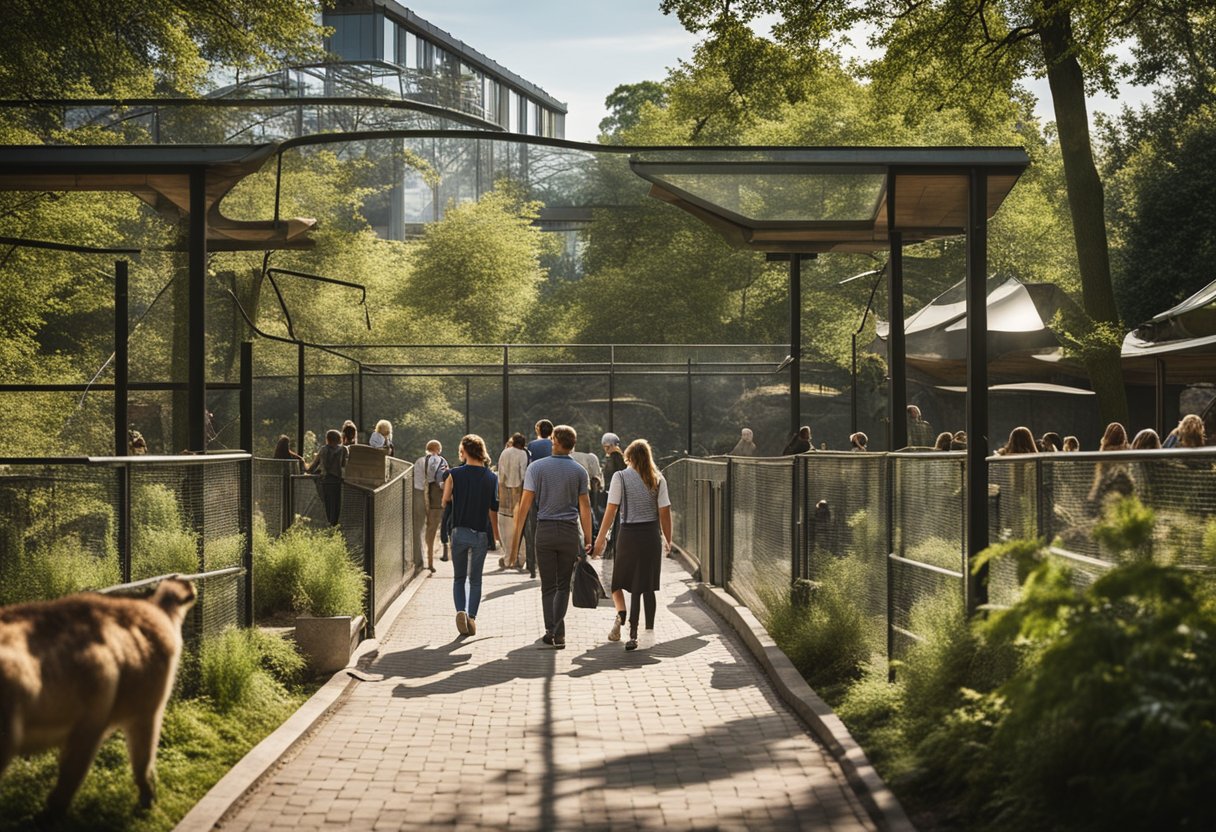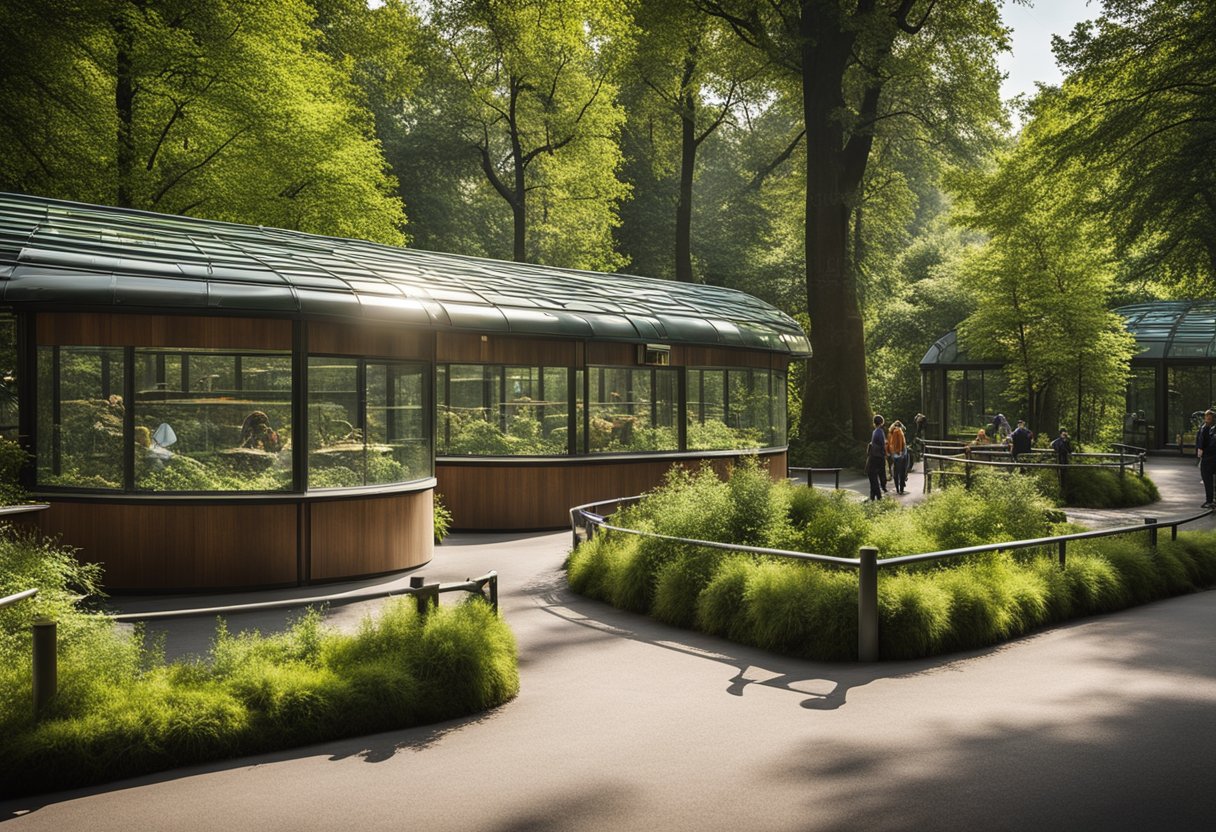Established in 1844, the Berlin Zoological Garden is a historic institution that earns its distinction as Germany’s oldest zoo.
Located in what was once West Berlin, the zoo serves as a testament to the city’s commitment to conservation and biodiversity.
Nestled in the lush expanse of Tiergarten, the zoo has evolved into a respected scientific institution attracting visitors from around the world.
With its prestigious reputation, the Berlin Zoo proudly holds the title of the most frequently visited wildlife park in Germany. This urban oasis offers sanctuary to the world’s largest variety of species in a zoo, showcasing a rich tapestry of wildlife from every corner of the planet.
The modern facilities interwoven with its traditional roots make the zoo not just a place of entertainment, but also an important center for zoological research.
In addition to the main location at the Zoologischer Garten, Tierpark Berlin complements the city’s zoological offerings as another prominent animal park, expanding the opportunities for education and conservation.
Together, these parks illustrate Berlin’s passion for nature and commitment to providing sanctuary for thousands of animals, while also educating the public on the vital role of species preservation.
History and Development- Berlin Zoo
Zoo Berlin, Germany’s first zoo, stands as a testament to historical progression, surviving wars and evolving through modernization initiatives, making it a focal point of the city’s heritage.
Foundation and Growth
Zoo Berlin was inaugurated on 1 August 1844, making it the oldest zoo in Germany. It owed its creation to King Frederick William IV, who donated animals from his own menagerie.
Prominent figures like Alexander von Humboldt and Peter Joseph Lenné played critical roles in its inception. Over time, iconic structures such as the Elephant Gate and Lion Gate became landmarks of the institution, symbolizing its growth and grandeur.
Impact of Wars
The course of World War II deeply scarred Berlin, and the Zoo was no exception. Devastating bombings led to severe damage and loss of many animals. Despite this, the Zoo managed to reopen quickly after the end of the war.
It endured through the division of Berlin into East and West, eventually becoming a symbol of reconstruction and resilience within the fabric of the city reunited post-war.
Modern Developments
Under the guidance of its Director Andreas Knieriem, Zoo Berlin has continued to modernize and champion conservation efforts.
Post-war reconstruction melded into ongoing efforts to enhance habitats and improve the living conditions for a range of species.
This focus on modernization ensures that Zoo Berlin remains a place where history is respected and the future of animal conservation is actively shaped.
Animal Exhibits and Collections
The Zoo Berlin, also known as the Berlin Zoological Garden, showcases a diverse array of animal species, from the popular giant pandas to the rare birds in its aviary. Revered for its diverse collection, the zoo provides a comprehensive view into the world of animals.
Mammals
The zoo’s collection of mammals is impressive, including crowd favorites like giant pandas and polar bears. A notable exhibit is dedicated to predators such as big cats, allowing visitors to observe lions, tigers, and leopards up close.
Additionally, the primate houses feature intelligent and social species such as gorillas, chimpanzees, and bonobos. The expansive habitats are tailored to each species, with areas like the hippo enclosure designed to mimic natural environments.
Birds and Aviary
Within the aviary structures, a variety of birds flit and fly in settings that reflect their natural habitats. The diversity is vast, ranging from tropical songbirds to majestic raptors. The bird collection at Zoo Berlin is known for not only its size but also the care given to the nurturing and conservation of different species.
Reptiles and Amphibians
Reptiles and amphibians are housed in carefully climate-controlled terrariums to mimic their diverse natural climates. Enthusiasts can marvel at creatures ranging from tiny poison dart frogs to formidable Komodo dragons.
Efforts in conservation and education are especially notable in these exhibits, highlighting the zoo’s role in preserving sensitive species.
Aquatic Species
Visitors can explore Aquarium Berlin for a journey through various aquatic habitats, where myriad fish species can be seen gliding through the water.
Significant aquatic inhabitants also include a mesmerizing hippo exhibit and enclosures showcasing polar ecosystems and the resident polar bear – a nod to the zoo’s history with Knut, the famous polar bear cub.
Conservation and Research
The Berlin Zoological Garden is a forerunner in conservation and research, maintaining comprehensive collections of species and spearheading numerous projects aimed at protecting wildlife.
Its efforts are critical in combatting the extinction of rare species, with programs designed to ensure the continuation of species-rich environments.
Studbooks and Breeding Programs
The zoo maintains a vast network of studbooks and heads breeding programs pivotal for the survival of over 1,400 species. These studbooks, including some that are international, serve as detailed genetic records that guide breeding efforts to preserve genetic diversity and prevent inbreeding.
The Berlin Zoo collaborates globally to manage these breeding programs, playing a key role in safeguarding the future of many rare and endangered species.
Species Protection Efforts
Efforts to protect species extend beyond the confines of the zoo, as the Berlin Zoological Garden is actively involved in worldwide conservation initiatives. They support habitats in the wild through both financial aid and expert assistance.
With over 20,000 animals in their care, the zoo acts as an ark, ensuring that future generations may continue to thrive in the wild. Their work emphasizes creating strategies for species adaptability and resilience in the face of anthropogenic changes.
Visitor Experience
The Berlin Zoo promises an enriching experience for all visitors, with a special emphasis on education, accessibility of exhibits, and a variety of zoo events and activities.
Educational Programs
The Berlin Zoo offers extensive educational programs aimed at both children and adults. Visitors can enjoy guided tours that provide insights into the lives of the many species housed here, including the famous polar bear Knut.
For more in-depth learning, the Zoo’s education department runs workshops and classes, teaching visitors about animal behaviors, conservation efforts, and biodiversity.
Exhibit Accessibility
The Zoo’s layout is designed for optimal accessibility, allowing guests of all ages to explore with ease. Key attractions such as the antelope house and the petting zoo are accessible to everyone, ensuring that children can interact closely with a variety of species.
Clear signage and maps are available, and tickets can be purchased for single entry or as part of a year-long pass, providing flexibility for both tourists and local residents.
Zoo Events and Activities
Throughout the year, the Berlin Zoo hosts a myriad of special events to engage with the local community and international visitors. From seasonal festivities to educational talks, there’s always something new and exciting happening.
The petting zoo is a delight for young children, while special exhibit openings provide a fresh experience for regular attendees. Keep an eye on the opening hours as they may vary for different events.
Zoo Facilities and Amenities
Berlin Zoological Garden provides a variety of facilities and amenities designed to enhance the visitor experience. From shopping for unique souvenirs to enjoying a variety of dining options, the zoo caters to all ages, ensuring a comfortable and family-friendly environment.
Gift Shops and Dining
Visitors to the zoo can explore several gift shops, each offering a range of souvenirs from plush animals to educational toys, reflecting the diverse species housed within the zoo.
Dining options are aplenty, with restaurants and eateries scattered across the premises, providing an array of culinary choices suitable for both children and adults.
- Souvenirs Available:
- Plush animals
- Educational toys
- Zoo-branded merchandise
- Dining Options:
- Fast food outlets
- Sit-down restaurants
- Coffee shops
Rest Areas and Playgrounds
For moments of rest, the zoo is equipped with numerous rest areas, strategically placed for visitor convenience. The facilities are clean and accessible, offering a respite between tours.
For the younger guests, the zoo features several playgrounds that are safe and engaging, allowing children to expend energy and interact in a fun, family-friendly setting.
- Rest Area Features:
- Benches
- Shade from trees
- Picnic spots
- Playground Highlights:
- Slides and swings
- Climbing structures
- Themed play zones
Zoo Management and Operations
The management and operations of the Zoo Berlin involve meticulous leadership, efficient financial handling, and ongoing maintenance, ensuring the zoo’s position as a leading institution for wildlife care and visitor experience.
Leadership and Administration
The administration of the Berlin Zoological Garden is spearheaded by a knowledgeable team, including a director responsible for setting the strategic vision and overseeing all zoo operations.
Dr. Andreas Knieriem, the current director, plays a crucial role in shaping the zoo’s future and ensuring high standards of animal care and visitor services.
The administrative staff works tirelessly to execute daily operations, manage staff, and maintain habitats, ensuring the well-being of both the animals and guests.
Financial Aspects
Financial management is key to the zoo’s sustainability, with funding derived from ticket sales, memberships, donations, and government grants.
The zoo’s budget is strategically allocated to various operations, including habitat maintenance, staff salaries, and development projects.
Continuous financial oversight ensures the zoo can continue its mission while also investing in infrastructure upgrades and facility enhancements necessary for the long-term growth and success of the zoo.
Maintenance and Development
Maintenance and development are critical in preserving the zoo’s reputation as a top-tier institution for conservation and education. The team is dedicated to habitat maintenance, ensuring that each species has an environment tailored to its needs.
This is complemented by ambitious development projects aimed at expanding and improving the zoo’s facilities, thereby enhancing the visitor experience and providing even more immersive and engaging ways to learn about and connect with wildlife.
The coordination of these efforts is crucial, requiring a clear understanding of both the current infrastructure and the potential for future growth.
Frequently Asked Questions
The Berlin Zoo, located in Germany’s capital, offers a variety of experiences for visitors. These FAQs are designed to provide essential information for planning a visit to this historic zoological garden.
How can I purchase tickets for the Berlin Zoo?
Tickets for the Berlin Zoo are available for purchase online, which allows visitors to plan their trip in advance and skip the lines upon arrival. It’s suggested to book tickets through the official website to ensure availability on your chosen date.
What kind of animals can I expect to see at the Berlin Zoo?
The Berlin Zoo is home to the largest variety of species in the world, including rare and exotic animals like giant pandas, which are a highlight for many visitors. One can encounter over 1,400 different species, ranging from amphibians to large mammals.
Is there a map available to help navigate the Berlin Zoo?
Yes, there is an interactive map available, as well as a downloadable map on their official website to help visitors orient themselves and plan their route through the many exhibits and attractions.
How much does it cost to enter the Berlin Zoo?
The cost of admission varies based on age, group size, and type of ticket. There are day tickets, annual passes, and options for group tickets. For up-to-date pricing, it is best to refer to the Zoo Berlin ticket page.
What are the opening times for the Berlin Zoo?
The Berlin Zoo’s opening times differ across seasons. Generally, it opens daily and has extended hours during the summer months. For the most accurate and current opening hours, visitors should check the official website.
Does the Berlin Zoo also include an aquarium and what are its features?
Indeed, the Berlin Zoo includes an impressive aquarium that houses a variety of aquatic and amphibian species, as well as invertebrates and tropical creatures. The aquarium is known for its biodiversity and themed habitats, such as the coral reef, rainforest, and crocodile hall.
